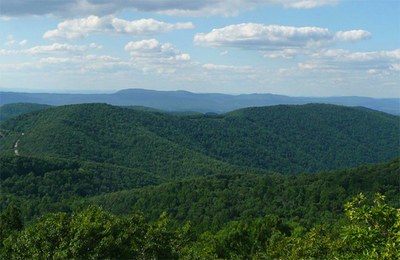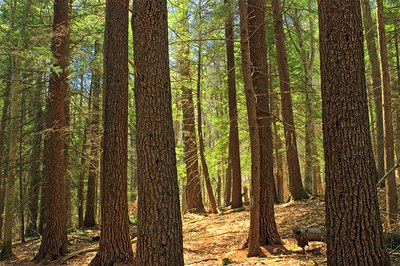Central Appalachians Forest Ecosystem Vulnerability Assessment and Synthesis: A Report from the Central Appalachians Climate Change Response Framework Project
Climate Change Response Framework
This summary is taken from text in the published assessment document referenced below.
Overview
This assessment is a fundamental component of the Central Appalachians Climate Change Response Framework project. The Framework is a collaborative, cross-boundary approach among scientists, managers, and landowners to incorporate climate change considerations into natural resource management. Six Framework projects are currently underway, covering approximately 250 million acres in the northeastern and midwestern United States: Northwoods, Central Appalachians, Central Hardwoods, Mid-Atlantic, New England, and Urban. Each project interweaves four components: science and management partnerships, vulnerability assessments, adaptation resources, and demonstration projects. We designed this assessment to be a synthesis of the best available scientific information on the topic of climate change and forest ecosystems. Its primary goal is to inform forest managers in the Central Appalachians region, in addition to people who study, recreate, and live in these forests. As new scientific information arises, we will develop future versions to reflect that accumulated knowledge and understanding. Most importantly, this assessment does not make recommendations about how this information should be used. The scope of the assessment is terrestrial forest ecosystems, with a particular focus on tree species. We acknowledge that climate change will also have impacts on aquatic systems, wildlife, and human systems, but addressing these issues in depth is beyond the scope of this assessment.
Key Findings

Forest ecosystems across the Central Appalachians will face direct and indirect impacts from a changing climate over the 21st century. This assessment evaluates the vulnerability of nine forest ecosystems in the Central Appalachian Broadleaf Forest and Eastern Broadleaf Forest – Oceanic Provinces of Ohio, Maryland, and West Virginia under a range of future climates. We synthesized and summarized information on the contemporary landscape, provided information on past climate trends, and described a range of projected future climates. This information was used to parameterize and run multiple vegetation impact models, which provided a range of potential tree responses to climate. Finally, we brought these results before a multidisciplinary panel of scientists, land managers, and academics familiar with the forests of this region to assess ecosystem vulnerability through a formal consensus-based expert elicitation process.
The summary of the contemporary landscape identifies major forest trends and stressors currently threatening forests in the region. Observed trends in climate over the past century reveal that average minimum temperatures have increased in the area, particularly in summer and fall. Precipitation has also increased in the area, particularly in fall. Projected climate trends for the next 100 years using downscaled global climate model data indicate a potential increase in mean annual temperature of 2 to 8 °F for the assessment area. Projections for precipitation indicate increases in winter and spring precipitation, and summer and fall precipitation projections vary by scenario. We identified potential impacts on forests by incorporating these future climate projections into three forest impact models (Tree Atlas, LINKAGES, and LANDIS PRO).  Model projections suggest that many mesic species, including American beech, eastern hemlock, eastern white pine, red spruce, and sugar maple may fare worse under future conditions, but other species such as eastern red cedar may benefit from projected changes in climate. Published literature on climate impacts related to wildfire, invasive species, and forest pests and diseases also contributed to the overall determination of climate change vulnerability. We assessed vulnerability for nine forest ecosystems in the assessment area. The assessment was conducted through a formal elicitation process of 19 science and management experts from across the area, who considered vulnerability in terms of the potential impacts and the adaptive capacity for an individual forest ecosystem. Appalachian (hemlock)/northern hardwood forests, large stream floodplain and riparian forests, small stream riparian, and spruce/fir forests were determined to be the most vulnerable ecosystems. Dry/mesic oak forests and dry oak and pine/oak forests and woodlands were perceived as less vulnerable to projected changes in climate. These projected changes in climate and the associated impacts and vulnerabilities will have important implications for economically valuable timber species, forest-dependent wildlife and plants, recreation, and long-term natural resource planning.
Model projections suggest that many mesic species, including American beech, eastern hemlock, eastern white pine, red spruce, and sugar maple may fare worse under future conditions, but other species such as eastern red cedar may benefit from projected changes in climate. Published literature on climate impacts related to wildfire, invasive species, and forest pests and diseases also contributed to the overall determination of climate change vulnerability. We assessed vulnerability for nine forest ecosystems in the assessment area. The assessment was conducted through a formal elicitation process of 19 science and management experts from across the area, who considered vulnerability in terms of the potential impacts and the adaptive capacity for an individual forest ecosystem. Appalachian (hemlock)/northern hardwood forests, large stream floodplain and riparian forests, small stream riparian, and spruce/fir forests were determined to be the most vulnerable ecosystems. Dry/mesic oak forests and dry oak and pine/oak forests and woodlands were perceived as less vulnerable to projected changes in climate. These projected changes in climate and the associated impacts and vulnerabilities will have important implications for economically valuable timber species, forest-dependent wildlife and plants, recreation, and long-term natural resource planning.
Preferred citation
Butler, P., L. Iverson, F. R. Thompson, III, L. Brandt, S. Handler, M. Janowiak, P. D. Shannon, C. Swanston, K. Karriker, J. Bartig, S. connolly, W. D. Dijak, S. Bearer, S. Blatt, A. Brandon, E. Byers, C. Coon, T. Culbreth, J. Daly, W. Dorsey, D. Ede, C. Euler, N. Gillies, D. M. Hix, C. Johnson, L. Lyte, S. Matthews, D. McCarthy, D. Minney, D. Murphy, C. O'Dea, R. Orwan, M. Peters, A. Prasad, C. Randall, J. Reed, C. Sandeno, T. Schuler, L. Sneddon, B. Stanley, A. Steele, S. Stout, R. Swaty, J. Teets, T. Tomon, J. Vanderhorst, J. Whatley, and N. Zegre. 2014. Central Appalachians ecosystem vulnerability assessment and synthesis: a report from the Central Appalachians Climate Change Response Framework. Gen. Tech. Rep. NRS-124., U.S. Department of Agriculture, Forest Service, Northern Research Station, Newtown Square, PA.





















